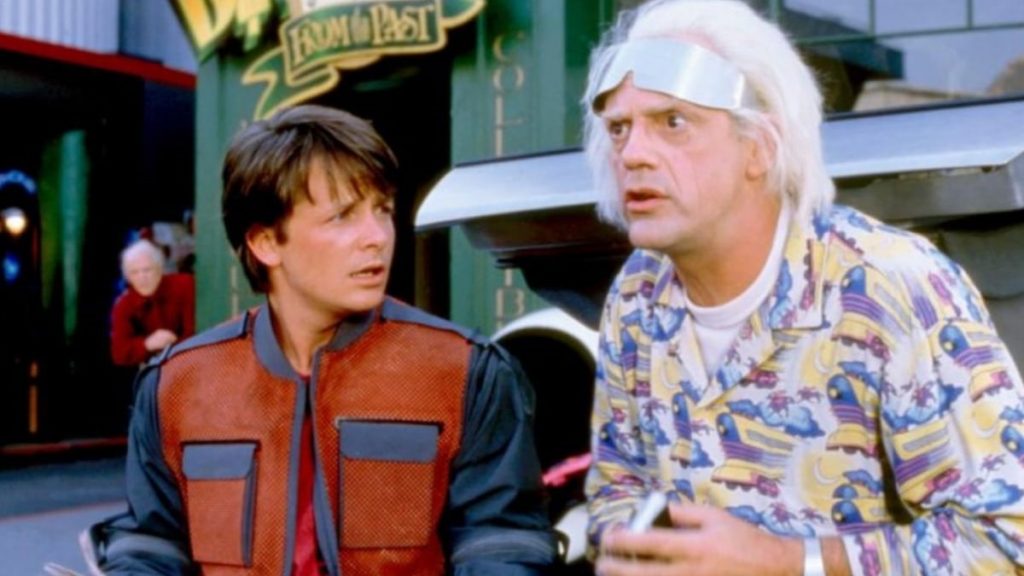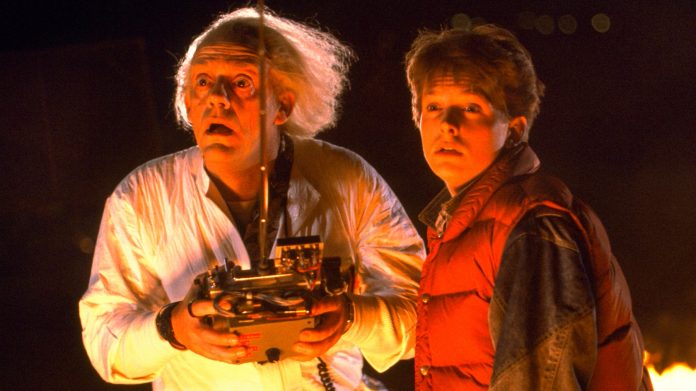Movie Monday: Film Recommendations By Our Contributors
Sit back and imagine yourself at seventeen in high school. What did you want to achieve? How fragile was your relationship with your parents? And do you still believe in what you thought? Back to the Future captures themes of adolescence and self-growth at the cusp of maturity, warping our imaginations to reconsider what life was like for our parents, and what it will be like for our children. In posing such questions, set to the kaleidoscopic background of ’80s electronica and Huey Lewis & The News, I argue that it’s both the greatest film ever made and the peak of cinematic excellence.
Marty McFly, played by original teen wolf heartthrob Michael J. Fox, is a high school student in 1985 balancing aspirations of becoming a musician whilst working with the community’s crazed local scientist. Dr. Emmett ‘Doc’ Brown, played by screen legend Christopher Lloyd, meets Marty at the local mall to reveal his latest invention; a time machine built into a DeLorean. Fleeing attackers targeting Doc, Marty helplessly escapes in the time machine and finds himself transported to 1955. What then ensues a comedic attempt to return to 1985 by creating a ripple in time and equipping the help of emergent scientist Doc, unaware and untrusting of Marty.

It is near impossible to highlight all of the unprecedented, phenomenal elements of this film. Considered as a whole however, Robert Zemeckis’ masterpiece criticises ageist narratives that infiltrate world views and relationships. From intergenerational friendships between Doc and Marty to immersive reflections on the McFly parents’ character development, Back to the Future rejoices in friendships across ages. Instead of disregarding his elders, Marty befriends them and empathises with their insecurities, aspirations, and passions. Not only does this not conform to the dominant caricature in film, that anybody over the age of forty is considered catatonic, but it puts respect and unity at the forefront of interactions between characters. It’s through this love of the past that we get to witness Marty’s passionate outburst of ‘Johnny. B. Goode.’ Those who continue to think this way, for example Principal Strickland, make themselves apparent by not fitting into the storyline and appearing absurd, reinforcing how backwards this ageist concept is in the first place.
Many of the themes which the film discusses remain prevalent in contemporary feminist and class discourse today. Marty’s parents live in the same suburban neighbourhood they did as children, working the jobs that their middle-class parents also had, destined to fulfil the same linear fate. As with Biff’s prosperity, his upper-middle-class status protects him from being held accountable for his misogynistic and violent behaviour towards his peers. More accurately, this attitude advantages him later in life, whilst Marty’s dad later works for him. Although his actions are glorified in the past, manipulation and coercive power dynamic structures are still at the forefront of present campaigns, including #MeToo and Black Lives Matter. Throughout the film, Marty begins to recognise the constraints under which his parents lived and proactively works to challenge and counteract them.
If you take a step back and consider the entire film trilogy, it possesses a unique power to recognise as individuals both where we are, where we’re going and where we’ve come from. Whilst Back to the Future Part II jumps to the year 2015, the anticipation for growth and development across society is evident on screen and massively contrasts from the 1955 setting of the first film. Although we still have a way to come in lieu of flying cars and hoverboards, witnessing the unadulterated hopes for the future feels introspective to what we want to achieve in our own lives across the next thirty years.
My personal favourite easter egg in the jam-packed films is the character Mayor Wilson; after witnessing his grandfather experience racist abuse whilst working at the local diner, the second film exonerates Wilson’s lineage by making himself and his grandson the Mayor. All too often films romanticise depictions of the past without reflecting the un-romantic inflictions which were forced onto many communities. Zemeckis doesn’t shy away from highlighting this in the film, instead using the characters’ appetite for change as an instrument to show these characters succeeding in the face of those who mistreat them. This celebrates how evolution is prevalent ubiquitously within the community and the broader thinking of the characters.
Before concluding the trilogy, Back to the Future Part III takes us even further into the past to witness Marty’s neighbourhood in 1885, on the cusp of Country-Western living. Undeniably the film includes many references to ‘cowboys and Indians,’ which monstrously labels Native and Indigenous American communities and continues to disparage the pain inflicted on them by representing them negatively on screen. Although the dialogue is intended to appear reflective of the characters of the time, the deep juxtaposition from the second film set over a century in the future hones in on the astronomical changes echoed in all aspects of daily living. Special recognition should also be given to the actors in the trilogy, who perform multiple characters of varied ages, each with conviction, creativity, and charisma. With a star-studded cast with multifaceted talents, it’s no wonder that each performance they provide is fondly remembered.
Back to the Future innovates a cinematic experience for its viewers by creating a neighbourhood where anyone has the potential to achieve anything they set their heart to. Encouraging us to take a pause to appreciate the beauty of the present, the films provide a much-needed break during the fast-paced intensity of the summer. Indulging science fiction tropes with wholesome family, alongside first love storylines and intergenerational best friends, Back to the Future confidently remains a beautiful film.
Words by Alanya Smith
Support The Indiependent
We’re trying to raise £200 a month to help cover our operational costs. This includes our ‘Writer of the Month’ awards, where we recognise the amazing work produced by our contributor team. If you’ve enjoyed reading our site, we’d really appreciate it if you could donate to The Indiependent. Whether you can give £1 or £10, you’d be making a huge difference to our small team.
